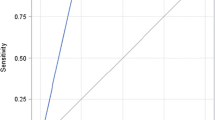Abstract
Introduction and hypothesis
This study aims to measure self-report urinary incontinence questions’ reproducibility and agreement with bladder diary.
Methods
Data were analyzed from the Reproductive Risk of Incontinence Study at Kaiser. Participating women reporting at least weekly incontinence completed self-report incontinence questions and a 7-day bladder diary. Self-report question reproducibility was assessed and agreement between self-reported and diary-recorded voiding and incontinence frequency was measured. Test characteristics and area under the curve were calculated for self-reported incontinence types using diary as the gold standard.
Results
Five hundred ninety-one women were included and 425 completed a diary. The self-report questions had moderate reproducibility and self-reported and diary-recorded incontinence and voiding frequencies had moderate to good agreement. Self-reported incontinence types identified stress and urgency incontinence more accurately than mixed incontinence.
Conclusions
Self-report incontinence questions have moderate reproducibility and agreement with diary, and considering their minimal burden, are acceptable research tools in epidemiologic studies.
Similar content being viewed by others
References
Landefeld CS, Bowers BJ, Feld AD et al (2008) National Institutes of Health state-of-the-science conference statement: prevention of fecal and urinary incontinence in adults. Ann Intern Med 148:449–458
(2000) Assessment and treatment of urinary incontinence. Scientific Committee of the First International Consultation on Incontinence. Lancet 355: 2153–8
Fantl JA, Newman DK, Colling J et al (1996) Urinary incontinence in adults: acute and chronic management. Clinical Practice Guideline no. 2. US Department of Health and Human Services. Public Health Service, Agency for Health Care Policy and Research, Rockville, MD
Hannestad YS, Rortveit G, Sandvik H, Hunskaar S (2000) A community-based epidemiological survey of female urinary incontinence: the Norwegian EPINCONT study. Epidemiology of Incontinence in the County of Nord-Trondelag. J Clin Epidemiol 53:1150–1157
Thom DH, van den Eeden SK, Ragins AI et al (2006) Differences in prevalence of urinary incontinence by race/ethnicity. J Urol 175:259–264
Sandvik H, Hunskaar S, Vanvik A, Bratt H, Seim A, Hermstad R (1995) Diagnostic classification of female urinary incontinence: an epidemiological survey corrected for validity. J Clin Epidemiol 48:339–343
Bent AE, Gousse AE, Hendrix SL et al (2005) Validation of a two-item quantitative questionnaire for the triage of women with urinary incontinence. Obstet Gynecol 106:767–773
Rohr G, Christensen K, Ulstrup K, Kragstrup J (2004) Reproducibility and validity of simple questions to identify urinary incontinence in elderly women. Acta Obstet Gynecol Scand 83:969–972
Brown JS, McNaughton KS, Wyman JF et al (2003) Measurement characteristics of a voiding diary for use by men and women with overactive bladder. Urology 61:802–809
Groutz A, Blaivas JG, Chaikin DC et al (2000) Noninvasive outcome measures of urinary incontinence and lower urinary tract symptoms: a multicenter study of micturition diary and pad tests. J Urol 164:698–701
Locher JL, Goode PS, Roth DL, Worrell RL, Burgio KL (2001) Reliability assessment of the bladder diary for urinary incontinence in older women. J Gerontol A Biol Sci Med Sci 56:M32–M35
Nygaard I, Holcomb R (2000) Reproducibility of the seven-day voiding diary in women with stress urinary incontinence. Int Urogynecol J Pelvic Floor Dysfunct 11:15–17
Wyman JF, Choi SC, Harkins SW, Wilson MS, Fantl JA (1988) The urinary diary in evaluation of incontinent women: a test–retest analysis. Obstet Gynecol 71:812–817
Streiner DL, Norman GR (1995) Health measurement scales: a practical guide to their development and use. Oxford University Press, New York
Stav K, Dwyer PL, Rosamilia A (2009) Women overestimate daytime urinary frequency: the importance of the bladder diary. J Urol 181:2176–2180
Kenton K, FitzGerald MP, Brubaker L (2006) What is a clinician to do–believe the patient or her urinary diary? J Urol 176:633–635
Acknowledgments
The Reproductive Risks of Incontinence Study at Kaiser was funded by the National Institutes of Diabetes, Digestive and Kidney Diseases (NIDDK) grant #5 R01 DK53335 and the NIDDK/Office of Research on Women’s Health Specialized Center of Research grant #P50 DK064538. Additional support included grant 5 K23 HD047654 (CSB) from the National Institutes of Child Health and Human Development.
Financial disclaimer/Conflict of interest
CS Bradley received research support from Pfizer and is a Consultant for Astellas/GSK. JS Brown also received research support from Pfizer. SK Eeden received research support from GSK. M Schembri, A Ragins, and DH Thom have nothing to disclose.
Author information
Authors and Affiliations
Corresponding author
Appendix. Self-report incontinence questions
Appendix. Self-report incontinence questions
Question used to identify “single question” self-reported incontinence type:
-
1.
During the past 7 days, did you accidentally leak urine most often with? (Check one box only.)
-
□ an activity like coughing, lifting, sneezing or exercise
-
□ following a physical sense of urgency that you were going to urinate
-
□ neither an activity nor a sense of urgency
-
□ about equally often with an activity or with a sense of urgency
-
Questions used to identify “3 question” self-reported incontinence type:
-
1.
During the past 7 days, how many times total did you accidentally leak urine with an activity like coughing, lifting, sneezing or exercise? _____
-
2.
During the past 7 days, how many times total did you accidentally leak urine with a physical sense of urgency? (Urgency is defined as a strong urge or pressure to urinate.) _____
-
3.
During the past 7 days, how many times total did you accidentally leak urine without a sense of urgency and without an activity like coughing, lifting, sneezing or exercise? _____
Rights and permissions
About this article
Cite this article
Bradley, C.S., Brown, J.S., Van Den Eeden, S.K. et al. Urinary incontinence self-report questions: reproducibility and agreement with bladder diary. Int Urogynecol J 22, 1565–1571 (2011). https://doi.org/10.1007/s00192-011-1503-3
Received:
Accepted:
Published:
Issue Date:
DOI: https://doi.org/10.1007/s00192-011-1503-3




